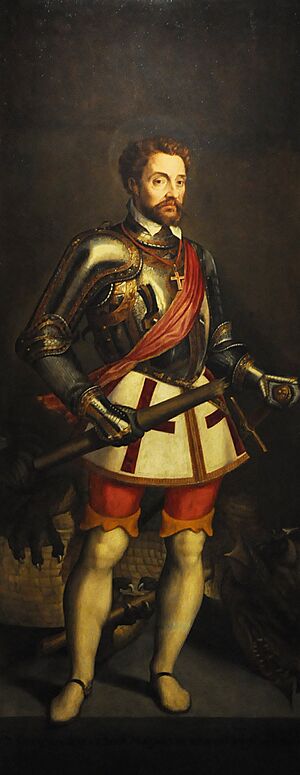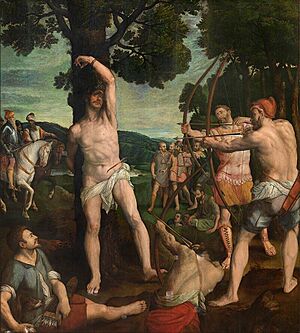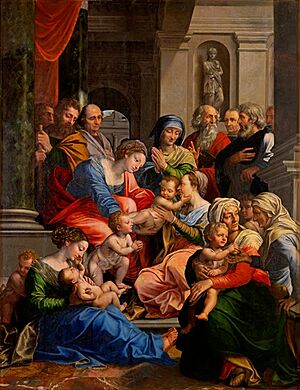Michiel Coxie facts for kids
Michiel Coxie (born 1499, died 1592) was a famous Flemish painter. He created beautiful altarpieces and portraits. He also designed stained-glass windows, tapestries, and prints. Michiel Coxie worked for important people in Flanders. He even became the official painter for Emperor Charles V and later for King Philip II of Spain.
People at the time called Coxie the Flemish Raphael. This was because they thought he was as good as the Italian master Raphael. Coxie spent 10 years in Italy. There he studied ancient Roman art and works by great artists like Raphael, Michelangelo, and Leonardo da Vinci. This greatly influenced his style. His new and bold art inspired later Flemish artists, including Peter Paul Rubens. Coxie helped connect older Flemish art with the new Flemish Baroque style. He also made famous copies of other artworks, like the Ghent Altarpiece by the van Eyck brothers. He also copied the Descent from the Cross by Rogier van der Weyden.
Contents
Michiel Coxie's Life
Early Years and Training
We don't have many records about Michiel Coxie's early life. We believe he was born in 1499. Most experts think he was born in Mechelen, a city in Belgium. This is where he returned after living in Italy for a long time.
It's also not clear who taught him to paint. Many clues suggest he trained with Bernard van Orley in Brussels. Van Orley was a well-known master painter. Coxie was asked to finish stained-glass windows for a Brussels cathedral after van Orley died. This also points to him being van Orley's student.
Travels and Italian Influence
The first clear records of Michiel Coxie are from when he lived in Rome, Italy. An Italian writer named Giorgio Vasari knew Coxie. Vasari wrote that Coxie painted frescoes (wall paintings) in a church called Santa Maria dell'Anima. He likely started these around 1531. Fresco painting was an Italian technique, new to Flemish artists. This means Coxie must have lived in Italy for a while to learn it. He probably arrived around 1527.
His frescoes in Rome made him famous. In 1534, he joined the Compagnia di San Luca, Rome's painters' guild. He was one of the first Flemish artists to join this group. Coxie stayed in Italy until the late 1530s. He worked on many projects, including decorating the new St. Peter's Basilica. He also designed prints for Italian engravers. One famous series of 32 prints showed the story of Amor and Psyche.
Returning to Flanders
In 1539, Coxie traveled back home through Milan. He designed two tapestries there. He first settled in Mechelen, joining the local painters' guild. He married Ida van Hasselt. They had several children, including Raphael Coxie, who also became a successful painter. Another son, Willem, also became a painter.
When he returned, Coxie was very popular. His first major work was 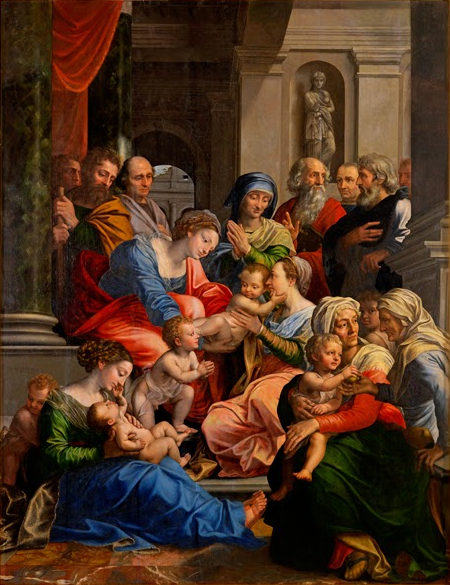 in 1540. This large painting showed the Virgin Mary and her family. It was set in grand Renaissance architecture. This work was the first time many people in Flanders saw the impressive High Renaissance style.
in 1540. This large painting showed the Virgin Mary and her family. It was set in grand Renaissance architecture. This work was the first time many people in Flanders saw the impressive High Renaissance style.
After Bernard van Orley died in 1541, Coxie took over his work designing stained-glass windows for a Brussels cathedral. He then designed windows for St Bavo's Cathedral in Ghent. Around this time, he became the court painter for Mary of Hungary. She was the sister of Emperor Charles V and ruled the Netherlands. Coxie also painted frescoes for a new castle in Binche. In 1543, he became a citizen of Brussels and joined its painters' guild. Brussels was the capital then. He ran a large workshop and became very successful.
Coxie also became a top designer of tapestry cartoons (the drawings used to make tapestries). Brussels was a world center for tapestries. He was even named the city's official cartoon painter. He designed tapestries for King Sigismund II Augustus of Poland. These included scenes from the Bible. He may also have designed tapestries for King Philip II of Spain.
Royal Patronage and Challenges
Emperor Charles V ordered many works from Coxie. Other important people also hired him. Coxie designed decorations for Prince Philip II's visit to Brussels in 1549. He also painted portraits of the royal family. When Charles V gave up his throne to his son Philip II in 1555, Philip continued to support Coxie.
King Philip asked Coxie to make an exact copy of the famous Ghent Altarpiece. Coxie moved to Ghent from 1557 to 1559 to do this. After finishing the copy, he moved back to Mechelen. He became part of local clubs there. Philip II also asked Coxie to copy Rogier van der Weyden's Descent from the Cross. Coxie also painted St. Cecilia at the Virginal for King Philip in 1569.
In 1566, a wave of destruction called the Beeldenstorm (Iconoclastic Fury) swept through Flanders. Many religious artworks were destroyed. Coxie, a loyal Catholic, tried to defend Mechelen from the iconoclasts. This showed his strong faith and loyalty to the king. This loyalty earned him protection from powerful figures like the Duke of Alba.
This time was hard for Coxie. His son Willem was wrongly arrested in Italy for heresy. He was sentenced to forced labor. But powerful people like the king's chancellor and King Philip himself helped free Willem. This shows how much support Coxie had. The Duke of Alba even protected Coxie and his son Raphael from having soldiers stay in their homes.
Coxie's first wife died in 1569. He remarried Jeanne van Schelle and had two more children. One of them, Michiel the Younger, also became a painter. In 1572, Spanish troops attacked Mechelen. Coxie was likely in Spain at the time. His house was looted. Some of his tapestry designs were stolen but later bought back by other painters.
After returning, Coxie stayed in Mechelen and took on new students. But Mechelen was struggling. Antwerp offered more opportunities for artists. Coxie completed an altarpiece in Antwerp in 1575 and joined its painters' guild in 1578. He stayed in Antwerp even when it was ruled by a Calvinist government, and still got commissions.
When Spanish Catholic rule returned to Antwerp in 1585, Coxie immediately received new commissions. King Philip continued to support him, giving him a yearly payment in 1589. Coxie kept painting even when he was over 90 years old. His last known work, from 1592, was the 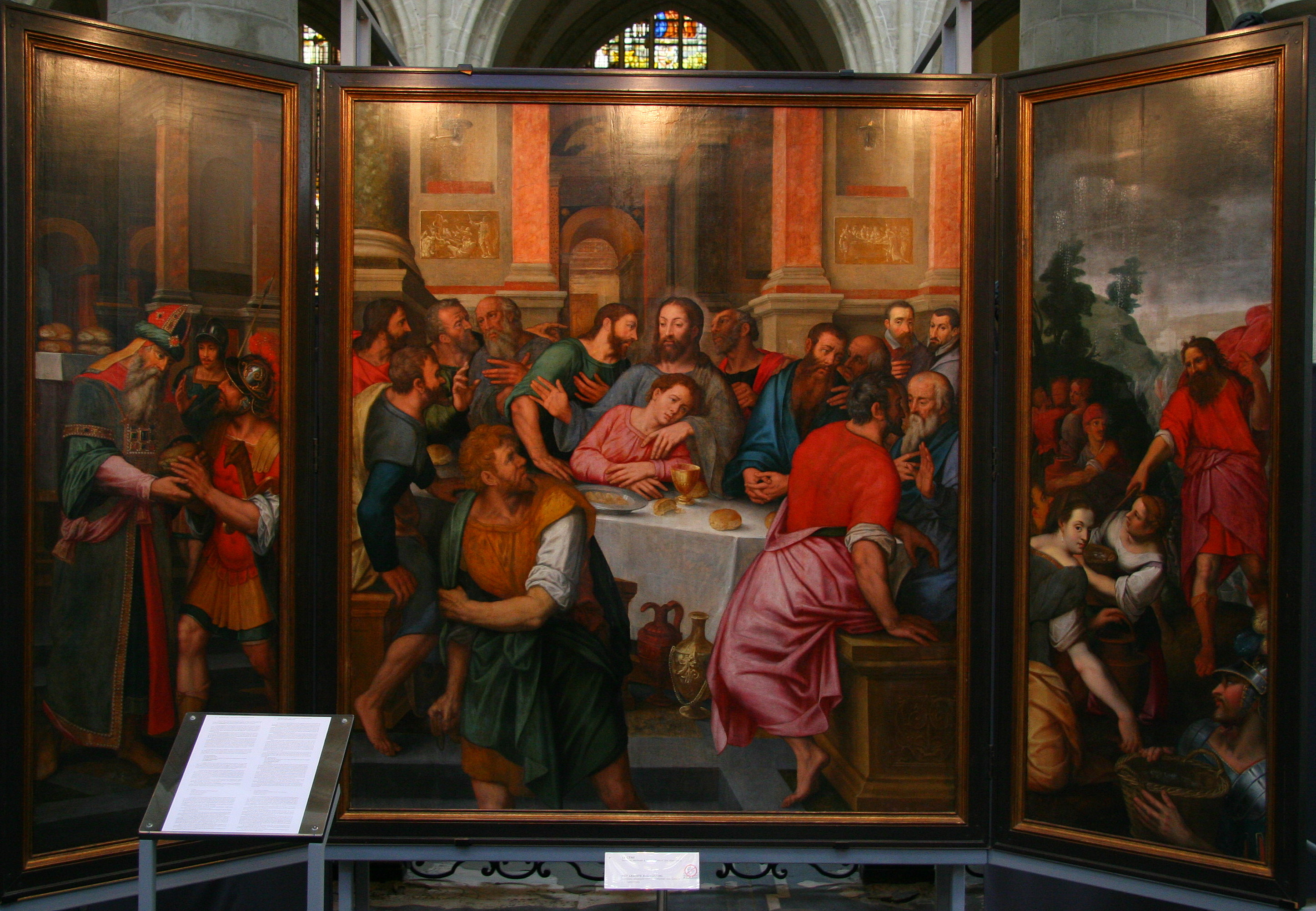 . It included a portrait of King Philip II. Coxie died shortly after, falling from a scaffold while restoring one of his own paintings in the Antwerp City Hall.
. It included a portrait of King Philip II. Coxie died shortly after, falling from a scaffold while restoring one of his own paintings in the Antwerp City Hall.
Michiel Coxie's Artworks
Artistic Style
Michiel Coxie was a very productive artist. He painted altarpieces and portraits. He also designed stained-glass windows, tapestries, and prints. He was skilled in both traditional Flemish oil painting and the Italian fresco technique. His career lasted almost the entire 16th century. He had a large workshop, which helped him produce many works and become famous. After he died, his style became less popular as the new Baroque style, brought by Rubens, took over.
Coxie's art blended Flemish and Italian styles. His teacher, Bernard van Orley, had learned about Italian Renaissance art from Raphael's designs. Van Orley made his figures more grand and heroic. He also added classical buildings to his paintings. In Italy, Coxie directly studied works by Raphael, Michelangelo, and ancient Roman art. He also read classical books.
His painting Plato's Cave shows these influences. It refers to Plato's idea about how art tries to show reality. Coxie explored how art can truly show what's real. He used ideas from Michelangelo and ancient statues. For example, a Roman statue called Falling Galatian inspired a figure in the painting.
The triptych  (1540) shows his unique style. It was painted for a guild in Antwerp. The painting features the Virgin Mary and her family in a grand Renaissance setting. It shows Coxie had mastered the Italian style but kept his Flemish roots. The Virgin's figure is like those by Da Vinci. The columns and drapes are inspired by Raphael. But the detailed work and rich colors are very Flemish, like the art of Jan van Eyck and Rogier van der Weyden.
(1540) shows his unique style. It was painted for a guild in Antwerp. The painting features the Virgin Mary and her family in a grand Renaissance setting. It shows Coxie had mastered the Italian style but kept his Flemish roots. The Virgin's figure is like those by Da Vinci. The columns and drapes are inspired by Raphael. But the detailed work and rich colors are very Flemish, like the art of Jan van Eyck and Rogier van der Weyden.
Designs for Prints
Like many artists, Coxie designed images for printers and engravers. One important series of prints he designed told the story of Amor and Psyche. For a long time, people thought Raphael designed this series. This shows how skilled Coxie was as a draftsman. Giorgio Vasari, who knew Coxie, confirmed that Coxie made the original sketches. Another series of prints by Coxie showed the stories of The loves of Jupiter. He based these designs on ancient stories and artworks, as well as works by Raphael and Michelangelo.


